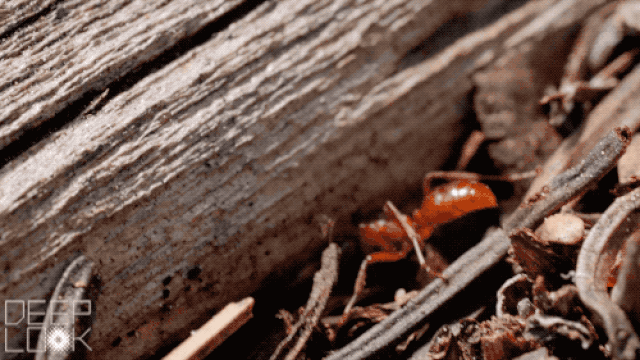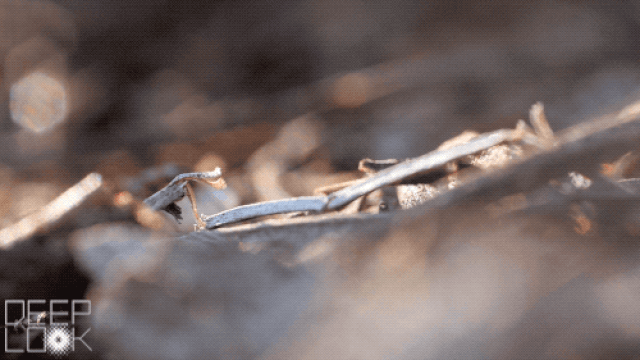Hard to believe but true: Ants specialize in 'kidnapping children' to survive
"Abduction of children ', an act that seems to exist only in humans appears in insects, in particular ants. Each kidnapping takes place publicly, with a scale of thousands. the individual, and the hostage's outcome after these missions, will surprise you.
Naturally, the kidnapping behavior of ants is not for the sake of making money, but is directly related to their survival. Specifically, from birth, the jaws of abducted ants have no jagged teeth, which makes them unable to chew food themselves. Therefore, abducted ants will have to accept starvation if no solution is found. Their 'vital' option in this case is to look for 'slaves' to help them chew their food.
How is a kidnapping conducted?
To conduct a kidnapping mission, the ant will first send groups of ants to spy on the surrounding area. Once a potential target is discovered - The nest of other ants (usually black ants) - the Reconnaissance force will quickly return to report for the entire deployment of a swift attack.

Abducted ants dig their way into the nest of black ants.
Catching the attack, the abducted ants will pull a large force of up to hundreds, even thousands of individuals, quickly approaching the nest of prey. Their targets were often very cautious because of the presence of regional kidnappers, so at the end of the day they would block the entrance of their nests with earth, small branches and gravel.
However, it didn't take long for this kidnapping army to break through the 'gates', and once penetrating the defenses, the abducted ants would quickly go to the location of the young, black ants. in the final developmental state before becoming an adult ant.

Ants kidnapping with booty: Black ant larvae.
After finding the target, the abducted ant will grab the black nymph with its long upper jaw, which is specialized for picking up the larvae, without hurting them. Besides, this pair of jaws is also very effective in battles when the sharp tip helps penetrate the outer skeleton of the enemy.
Immediately after completing the abduction mission, the ants will return to their nests in the same way they came. However, the story never stops here!
What do abducted ants do with their hostages?
Ants live in a world of chemicals! Unlike us, ants do not have a nose, they use their antennae at the head to sense the world, find food as well as identify swarms and strangers.
Ants can create their own unique smell. Each ant colony has a unique smell, which is a combination of chemicals from ants in the mix with chemicals from food and habitat.

Ants touch antennae together to communicate.
The ant collects scents through a gland in its corner, similar to a bag filled with chemicals derived from whatever ants have interacted with. At the same time, so that the opponent can identify themselves, ants will also cover themselves with the specific scent of the herd.
So what does this have to do with the abduction of the strange ant mentioned above?
It should be noted that, when newly hatched from the cocoon, the ants basically do not have any recognizable odor. Therefore, even when kidnapped, they did not know that they were being held in a strange place.
Along with that, kidnapping ants will perform a trick to deceive their victims, by covering the black ant larvae with the characteristic scent of kidnapping ant nests, thereby making them think they are inherently about this place. The easy brainwashing with only the scent is the reason ants kidnap their choice of larvae instead of adult ants.

The abducted ants cover the black ant larvae, the characteristic scent of abducted ant nests, which makes them think that they belong to this place.
When growing up, the black ants will take on the task of foraging, raising young and other activities to maintain the nest for kidnapping. In addition, since it is impossible to chew food on its own, 100% of abducted ants' diet will depend on black ants, so these 'slaves' will have to perform one more unjust task: to feed. for the owner.
Specifically, abducted ants and black ants will touch their mouths like kissing positions; Next, the black ant releases the chewed food directly into the abducted ant's mouth, this behavior is called 'Food Exchange'. According to scientists, the food exchange is very popular among individuals of the same herd. However, it rarely happens between two different species as in this case.

Black ants feed the abducted ants.
The relationship between kidnapping ants and their 'slave' is considered to be a parasitic relationship . In particular, abducted ants is the parasite, the black ant is the host. The special thing here is that instead of sucking blood or taking nutrients, like most other parasitic relationships, this ant is doing resource suck.
- The principle that every adult must know to prevent kidnapping children
- The 'survival' rule must teach your baby to avoid kidnapping
- Ants summon their fellow humans to survive in the bunker
- The mysteries of Argentinian ants are aggressive
- Teamwork helps fire ants to die in floods
- Discover strange ants in the world
- Discover the life of ants through photos
- Strange things about the ant world
- 'Vampire' ants 98 million years die hard in the amber block
- Why ants 'dominate' the world
- Amazingly huge ants fire floating in the super typhoon in America
- The most mysterious kidnappings of UFOs ever recorded
 Why do potatoes have eyes?
Why do potatoes have eyes? 'Tragedy' the world's largest carnivorous life: Death becomes ... public toilet
'Tragedy' the world's largest carnivorous life: Death becomes ... public toilet Tomatoes were once considered 'poisonous' for 200 years
Tomatoes were once considered 'poisonous' for 200 years Detecting microscopic parasites on human face
Detecting microscopic parasites on human face